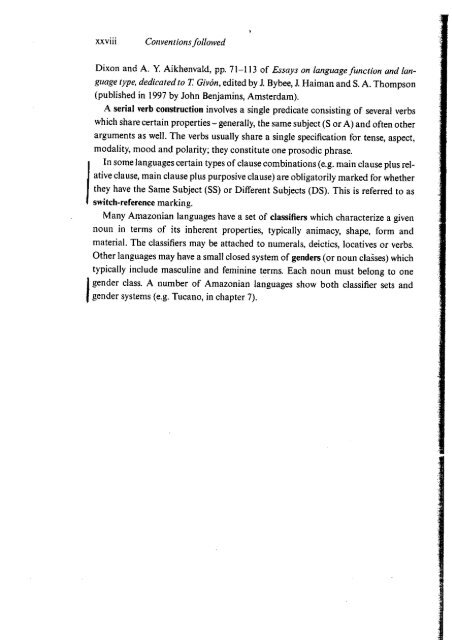The Amazonian Languages
by R.M.W. Dixon and Alexandra Y. Aikhenvald
by R.M.W. Dixon and Alexandra Y. Aikhenvald
Create successful ePaper yourself
Turn your PDF publications into a flip-book with our unique Google optimized e-Paper software.
xxviii<br />
Conventions followed<br />
j<br />
Dixon and A. Y Aikhenvald, pp. 71-113 of Essays on langllagefunction and langllage<br />
type, dedicated lo T. Givón, edited by 1. Bybee,1. Haiman and S. A. Thompson<br />
(published in 1997 by John Benjamins, Amsterdam).<br />
A serial verb construction involves a single predicate consisting of several verbs<br />
which share certain properties - generalIy, the same subject (S or A) and often other<br />
argllments as welI. <strong>The</strong> verbs usualIy share a single specification for tense, aspect,<br />
modality, mood and polarity; they constitute one prosodic phrase.<br />
In sorne languages certain types of cIause combinations (e.g. main clallse plus relative<br />
cIallse, main cIause plus purposive cIause) are obligatorily marked for whether<br />
they have the Same Subject (SS) or Different Subjects (DS). This is referred to as<br />
switch-reference marking.<br />
Many <strong>Amazonian</strong> languages have a set of c1assifiers which characterize a given<br />
noun in terms of its inherent properties, typicalIy animacy, shape, form and<br />
material. <strong>The</strong> cIassifiers may be attached to numeral s, deictics, locatives or verbs.<br />
Other languages may have a small cIosed system of genders (or noun classes) which<br />
typicalIy incIude masculine and feminine terms. Each noun must belong to one<br />
, gender cIass. A number of <strong>Amazonian</strong> languages show both cIassifier sets and<br />
gender systems (e.g. Tucano, in chapter 7).<br />
1 <br />
Introduction<br />
R. M. W. OIXON ANO <br />
ALEXANORA y. AIKHENVALO <br />
<strong>The</strong> Amazon basin is the least known and least understood linguistic region in the<br />
world. Maps of the language families of South America (with one colour for each<br />
genetic group) purvey an impression of anarchy - there are dabs of yellow and blue<br />
and red and orange and brown mingled together Iike a painting by Jackson Pollock.<br />
And when one does get hold of a grammar of an <strong>Amazonian</strong> language it is likely<br />
to show strange properties - multiple sets of cIassifiers, oddly conditioned ergativity<br />
splits, and so on - that constitute exceptions to received ideas about typological<br />
universals. In other instances one finds the richest examples of categories that are<br />
weakly attested elsewhere. For instance, Tucano languages (chapter 7) have the most<br />
highly articulated systems of evidentiality in the world; this is an obligatory<br />
specification of th~evidence a speaker has for making a statement - whether<br />
observed, or reported, or inferred, or assumed. However, a major difficulty is that<br />
a h.igh proportion of available grammars are incomplete, affording a g1impse of<br />
sorne exotic grammatical property but with insufficient information to enable the<br />
reader to fulIy understand it, and to realize its overall typological significan ce.<br />
In fact, the major language families all have markedly discontinuous distributions<br />
(more than is found in any other part of the world). <strong>The</strong> Tupí and Arawak<br />
families each comprise at least ten separate geographical regions and the Carib<br />
family at least five. Even Tucano, one of the most Iinguistically homogeneous of<br />
families, is spoken over three distinct areas. In addition, there has been a great deal<br />
of Iinguistic diffusion, over large and small regions within the Amazon River Basin.<br />
This can make it hard - sometimes impossible - to determine whether points of<br />
similarity between two languages in cIose proximity are evidence of shared genetic<br />
development, or simply of mutual borrowing.<br />
One of the editors has devoted several decades to searching for substantive linguistic<br />
universals. In case after case, just as he thought he had achieved sorne significant<br />
typological statement, a counter-example popped up; and this was<br />
invariably from a language of Amazonia. He decided that the most sensible course<br />
of action was to learn Spanish and Portuguese and then go to South America - visit


















